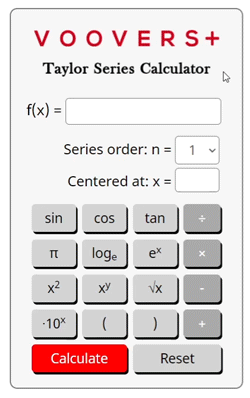Related Content
Taylor Series Calculator


To get unlimited answers, .


Taylor Series Lesson
Lesson Contents
Why do we Calculate a Taylor Series?
A Taylor series provides us a polynomial approximation of a function centered around point a. Because the behavior of polynomials can be easier to understand than functions such as sin(x), we can use a Taylor series to help in solving differential equations, infinite sums, and advanced physics problems. An infinite Taylor series of a function represents that function.
However, a finite Taylor series is just an approximation of the function, where the accuracy in which the Taylor series represents the function is positively correlated with the number of terms in the Taylor series. Carrying out more terms of the Taylor series will give us a more accurate approximation of the function.
The number of terms in the series is directly linked to the degree of the Taylor series. The degree of the Taylor series is the maximum n value written in the sigma notation. The number of terms in the series is n + 1 since the first term is created with n = 0. The highest power in the polynomial is n = n.
How to Calculate a Taylor Series
The formula for calculating a Taylor series for a function is given as:
Where n is the order, f(n)(a) is the nth order derivative of f(x) as evaluated at x = a, and a is where the series is centered. The series will be most accurate near the centering point.
As we can see, a Taylor series may be infinitely long if we choose, but we may also choose to make our series as many or little terms/accurate as we want. We can set a maximum n value to make it an n order Taylor series.
Example Problem
Find the second order Taylor series of the function sin(x) centered at zero.
Solution:
1.) We will set our terms f(x) = sin(x), n = 2, and a = 0.
2.) The zeroth, first, and second derivative of sin(x) are sin(x), cos(x), and -sin(x) respectively.
3.) Applying our derivatives to f(n)(a) gives us sin(0), cos(0), and -sin(0).
These simplify to 0, 1, and 0 respectively.
4.) Applying the rest of the formula gives us:
(0/0!)(x – 0)0 + (1/1!)(x – 0)1 + (0/2!)(x – 0)2
5.) This simplifies to the second order Taylor series of f(x) ≈ x.












